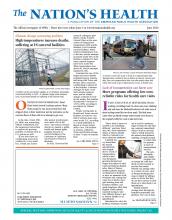
A worker carries vaccination supplies at a Cleveland, Mississippi, correctional facility in 2021. As climate change raises temperatures, incarcerated people are suffering in the extreme heat.
Photo by Spencer Platt, courtesy Getty Images
One recent hot summer day, David Cloud visited several Louisiana prisons. Many of the people he saw incarcerated there had stripped down to their underwear and lay motionless on the concrete floors of their cells in an attempt to get cool.
At the time, Cloud, PhD, JD, MPH, was researching solitary confinement, but the experience moved him to explore the growing problem of extreme heat in U.S. prisons as well.
“If you don’t have air conditioning, and you’re confined to a very small box, I think any reasonable person would experience quite a bit of distress,” said Cloud, research director at Amend, a public health and human rights program focused on carceral facilities at the University of California-San Francisco School of Medicine.
In 2023, Cloud and his research colleagues published a study in JAMA Network Open on the association of rising prison temperatures with suicide attempts at six Louisiana carceral facilities. When outdoor temperatures rose to the 80s, suicide attempts increased nearly 30% at the facilities compared to days when outdoor temperatures were in the 60s. When temperatures rose above 90, suicide attempts climbed by 36%.
Louisiana has one of the largest and most densely populated prison systems, and along with Texas and Florida, lacks central air conditioning in almost all of the facilities. Louisiana averages 35 days a year with extreme temperatures, and as climate change continues to heat up the nation, that number is projected to increase to 115 by 2050, according to an analysis by Climate Central.
People serving time in Florida and Texas carceral facilities account for over half of extreme heat exposures in the U.S., according to a study published in March in Nature Sustainability. Over 110 facilities in Arizona, California, Texas and Florida average at least 74 days of extreme heat.
But it is not just carceral facilities in the South where imprisoned people are suffering from higher temperatures.
In a study published last year in PLOS One, researchers looked at mortality in U.S. correctional facilities during summer months from 2001 to 2019. They found that a 10-degree rise in temperatures above the regional average led to a 5% overall increase in deaths, as well as a 6.7% increase in deaths from heart disease. In Northeast prisons, a two-day heat wave in the region corresponded with a 21% rise in carceral deaths, the study found.
People who work in carceral facilities, such as prisons, jails, detention centers and juvenile facilities, must bear extreme temperatures as well. In summer 2022, New Jersey’s Office of the Corrections Ombudsmen measured cell temperatures up to 88 degrees and 94 degrees on separate test days at three facilities.
“The Ombuds office heard reports of people engaging in assaultive behavior in order to be transferred to air-conditioned disciplinary housing assignments,” the report said. “The office also heard reports from staff and labor leaders that high heat increased irritability and slowed responses to prison security incidents.”
The New Jersey corrections office and Department of Corrections implemented access to ice, portable fans and more cooling stations on hot days for staff and people who were imprisoned. They also provided aid for people who were particularly heat sensitive, such as older adults and those with health issues exacerbated by extreme temperatures.

Following multiple heat-related deaths in carceral facilities without air conditioning in Texas in 2023, protestors head to the State Capitol building in Austin to call for action.
Photo by Sergio Flores, courtesy AFP/Getty Images
But without central air conditioning, that heat risk “will continue to surface each summer absent state appropriations for major building repairs,” the report said.
Carceral facilities tend to be built of heavy, heat-absorbing materials on open sites with few or no green canopies for shade, creating massive heat islands. Nearly 2 million incarcerated people are regularly exposed to extreme heat and humidity in the U.S., the Nature Sustainability study estimated. In 44 states, universal air conditioning is not required in carceral facilities.
Chronic heat exposure can cause heat stroke, nausea, hyperthermia, kidney disease and irritability. Moreover, nearly half of people in carceral facilities are estimated to have a diagnosed mental health condition, which can be exacerbated by chronic heat exposure.
Options for self-cooling using portable fans or ice are limited for people who spend most of their days locked in a cell, said Robbie Parks, PhD, senior author of the Nature Sustainability study and assistant professor of environmental health sciences at Columbia University Mailman School of Public Health.
High temperatures in carceral facilities have been called a human rights violation. But generating sympathy from the public, policymakers and the judicial branch to make central air conditioning mandatory in such facilities is challenging, Parks said.
To make headway, Parks suggested that the issue be framed as a violation of the Eighth Amendment, which precludes the U.S. government from inflicting cruel and unusual punishment on people, including those who are incarcerated.

Luis A. sits in his cell at a Chester, Pennsylvania, correctional facility in 2023. Despite rising heat from climate change, only six states mandate air conditioning in carceral facilities.
Photo by Kent Nishimura, courtesy The Los Angeles Times/Getty Images
“It would fall well within the definition of cruel and unusual punishment — to leave someone baking indoors with no ability to escape,” Parks said. “That is so obviously a constitutional issue. Do we really want to be a society that has this kind of vindictive nature, or do we want to be a society that treats all humans with dignity?”
“Do we really want to be a society that has this kind of vindictive nature, or do we want to be a society that treats all humans with dignity?”
— Robbie Parks
Given the fact that systemic racism has led to overrepresentation of Black people in carceral facilities, especially in the South, the problem is also an equal justice issue.
“Very few people in the United States touch the criminal justice system,” Cascade Tuholske, PhD, lead author of the Nature Sustainability study and assistant professor of human-environment geography at Montana State University, told The Nation’s Health. “But if you know anyone who has interacted with it, or if you have interacted with it yourself, it drastically changes your perception of the stereotype of who is incarcerated…It is not the boogeyman often sold to us.”
Parks and Tuholske recommend that advocates support state laws that mandate safe temperature ranges, enhance social and physical infrastructure, call for focused health system interventions and, most importantly, provide universal central air conditioning in carceral facilities.
“If you look at the bright side of American history, I think dignity is very much at the forefront of our national ethos, or at least that is what we tell ourselves,” Tuholske said. “But if you look at our actual history, it’s much more complicated. I would emphasize bringing back the dignity side of things.”
For more information, visit www.vera.org and www.amend.us.
- Copyright The Nation’s Health, American Public Health Association









